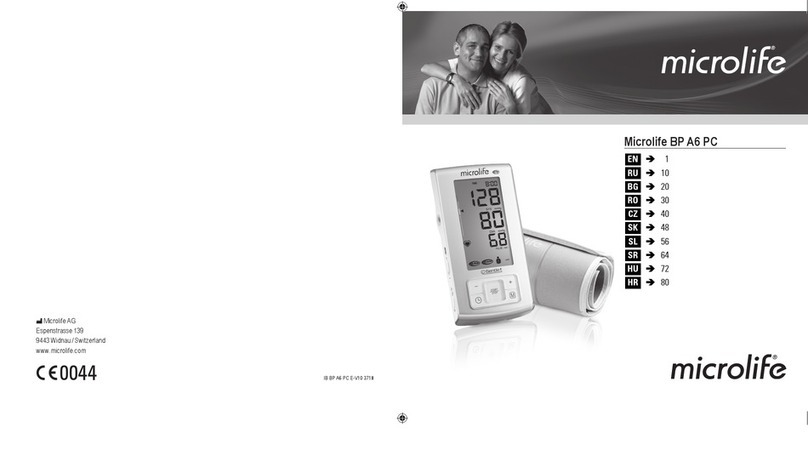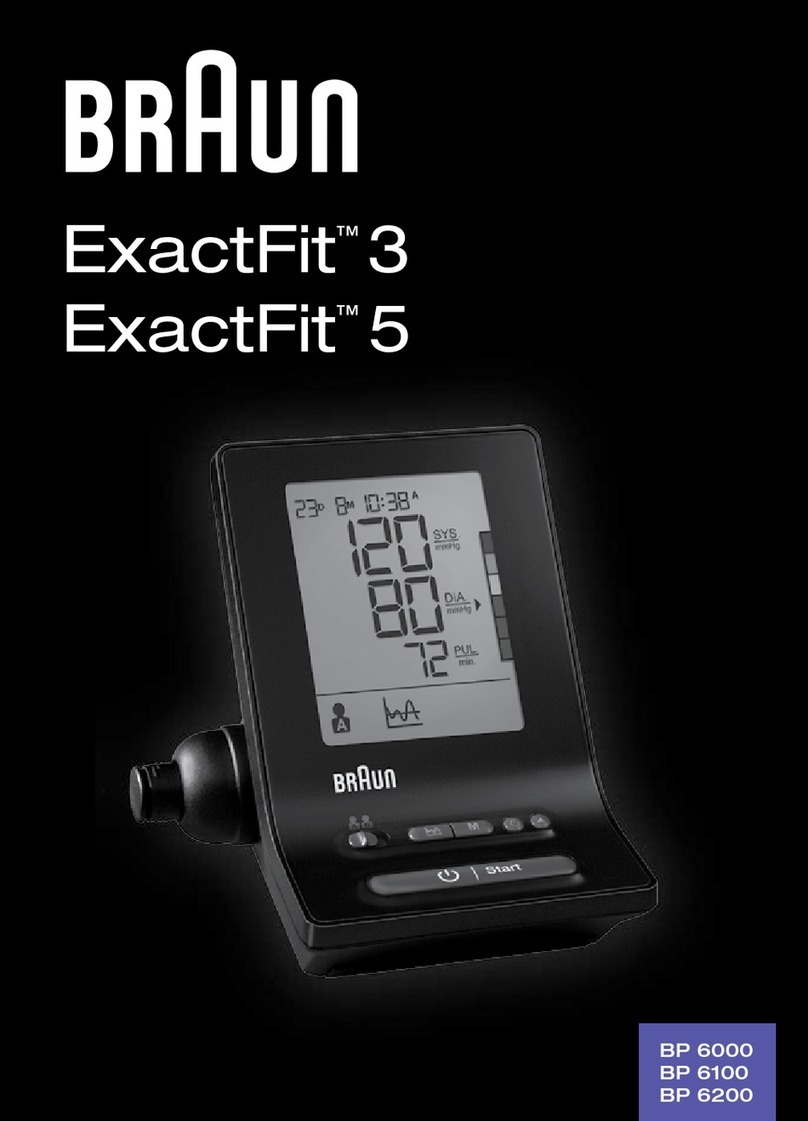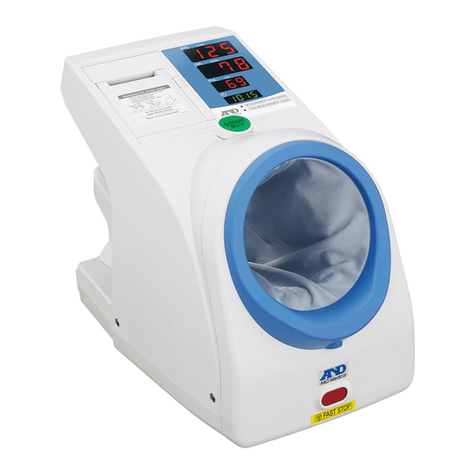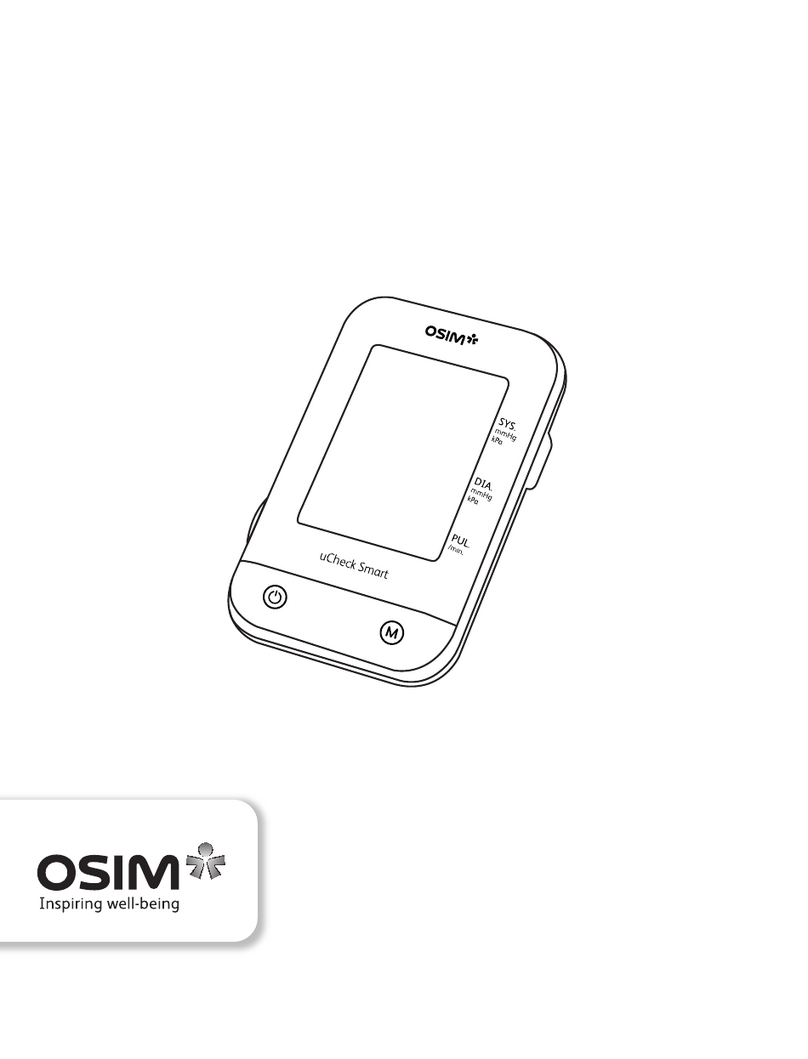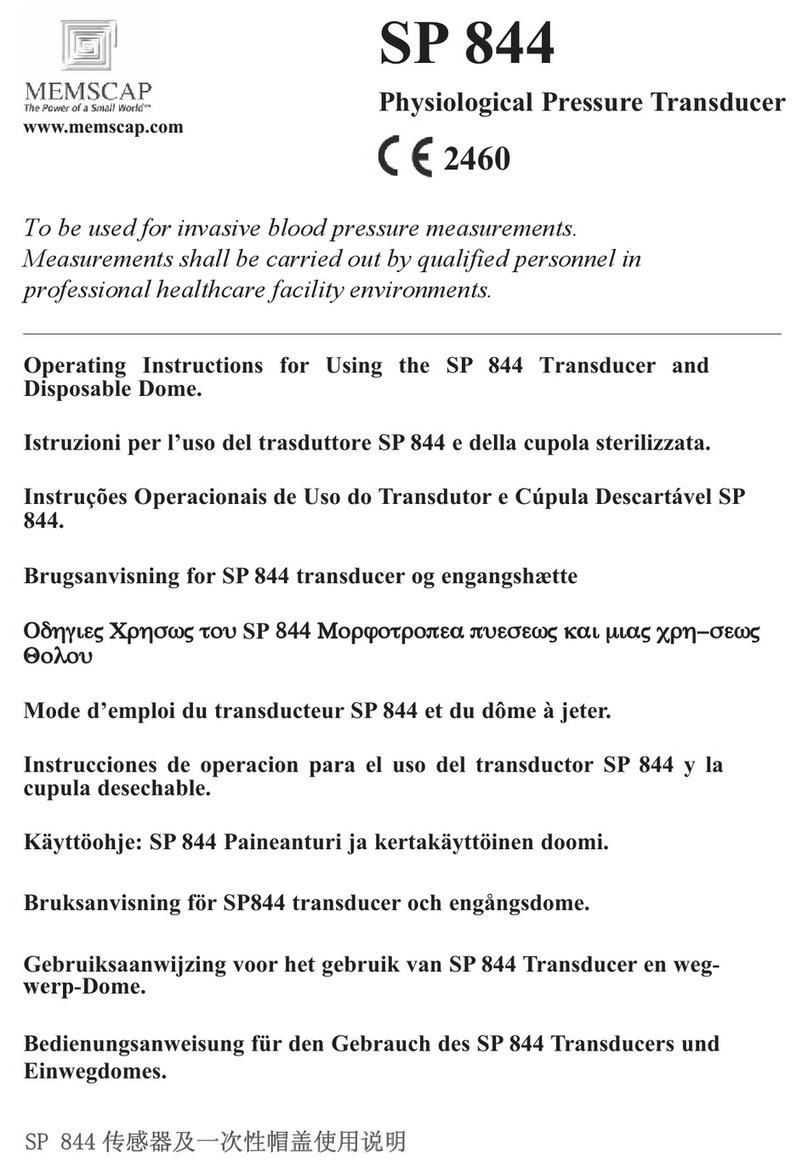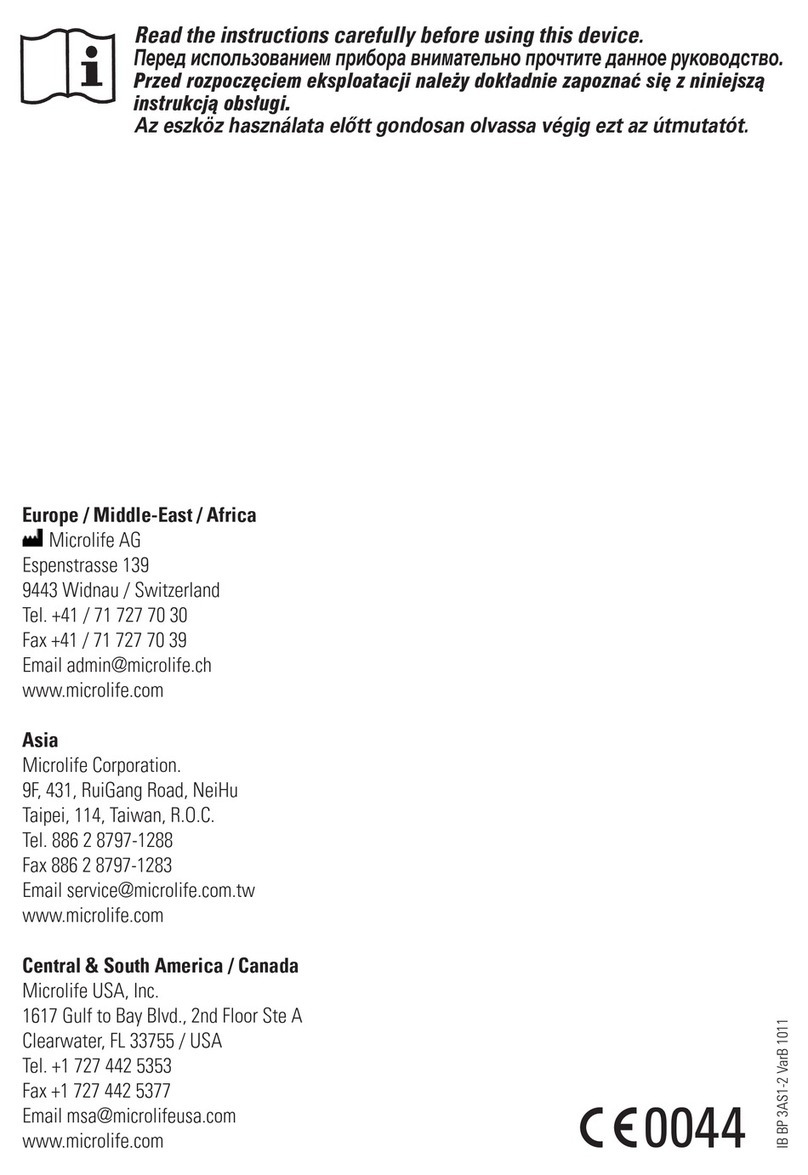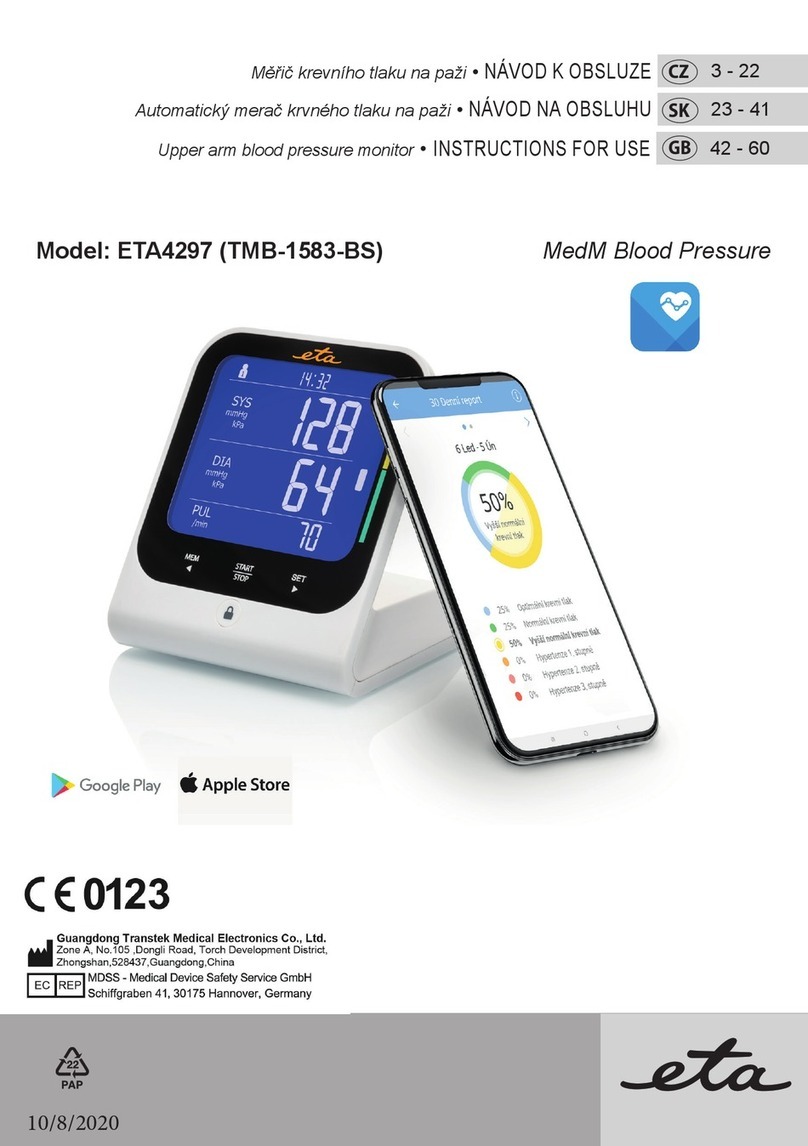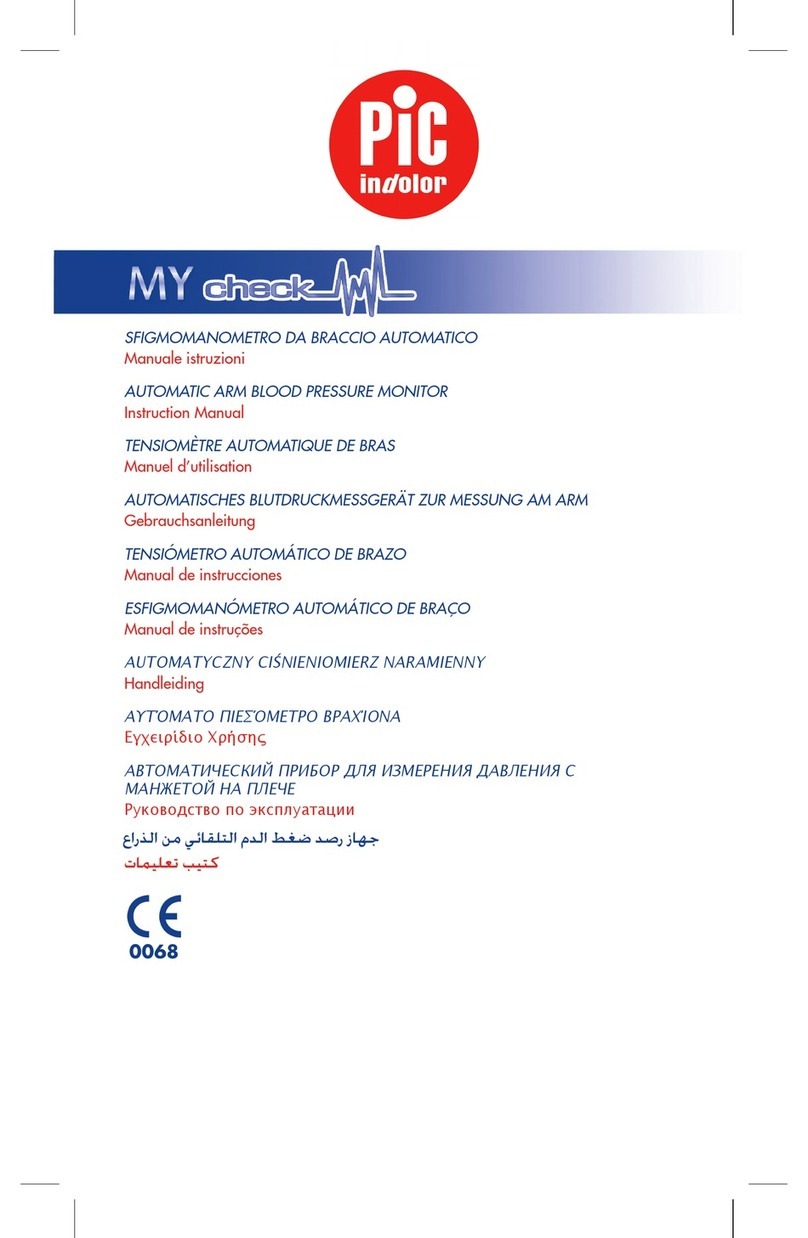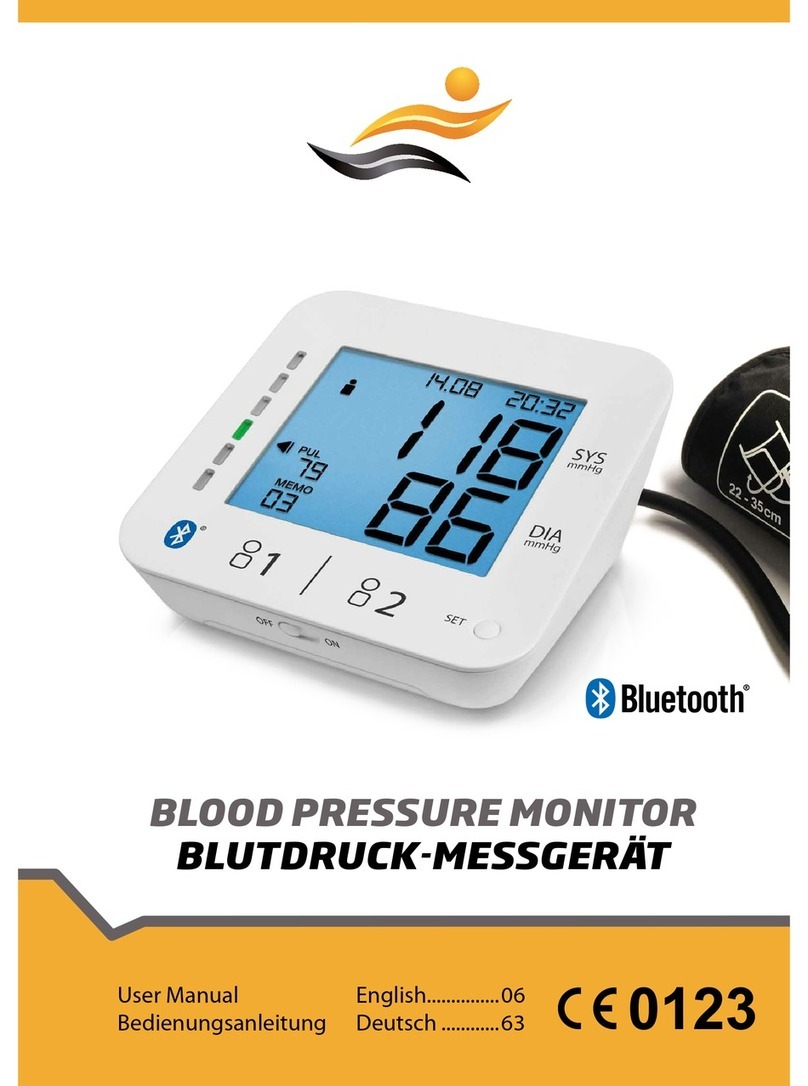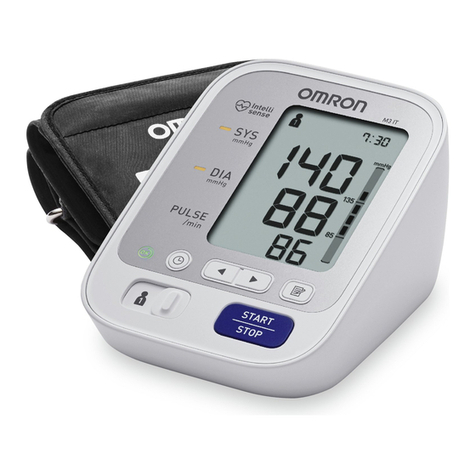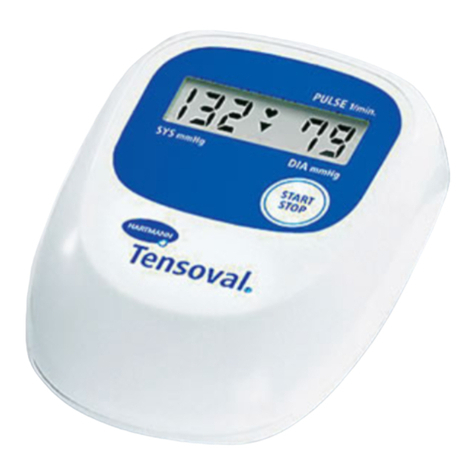HINGMED WBP-02A User manual

1
1639
Hingmed
Wearable Ambulatory Blood Pressure Monitor
User Manual
WBP-02A Hospital
Shenzhen Hingmed Medical Instrument Co., Ltd.
VER:A/3
Date: Jan, 2020

2
About this Manual
The manual mainly introduces the installation and application method of
Wearable Ambulatory Blood Pressure Monitor. Users should read
carefully before application (include warnings, contraindications and
notes).
Manufacturer:
Shenzhen Hingmed Medical Instrument Co., Ltd.
Manufacturing address: 4th Floor, Zhonghang Flying Industrial Building,
#371, Guangshen Road, Xixiang, Bao’an District, Shenzhen, China.
Web: www.hingmed.com
Tel: +86 755 23720600
Fax: +86 755 23720602
Post code: 518102
Service:
Company: Shenzhen Hingmed Instruments Co., Ltd.
Address: 4th Floor, Zhonghang Flying Industrial Building, #371,
Guangshen Road, Xixiang, Bao’an District, Shenzhen, China
Tel: +86 755 23720600
Fax: +86 755 23720602
Post code: 518102
European Representative:
Company Name: Wellkang Ltd
Company Address: The Black Church, St. Mary's Place,Dublin 7, D07
P4AX, Ireland
Tel: +353(1)2542900, +353 (1)4433560
Fax: +353(1)6864856
Web: www.wellkang.ltd.uk www.CE-marking.eu
Email: AuthRep@CE-marking.eu
Version Information
This manual may be upgraded due to software upgrading in the future. Users
may not get further update for manual upgrading.
■ Version: A/1
■ Issue date: Jan 2020
Shenzhen Hingmed Medical Instruments Co., Ltd. owns and reserves the
copyright.

3
Table of Content
Chapter 1 Preface............................................................................................................................ 5
1.1 Brief Introduction of Ambulatory Blood Pressure Monitoring..................................... 5
Chapter 2 Safety Requirements.................................................................................................... 7
2.1 Intended use.......................................................................................................................7
2.2 Contraindication.................................................................................................................8
2.3 Warnings............................................................................................................................. 8
2.4 Notice...................................................................................................................................9
2.4.1 Battery......................................................................................................................9
2.4.2 Training.................................................................................................................... 9
2.4.3 Blood pressure measurement..............................................................................9
2.4.4 Energy conservation and environment protection............................................9
2.4.5 Maintenance............................................................................................................9
Chapter 3 Product Introduction....................................................................................................10
3.1 Product composition:...................................................................................................... 10
3.2 Name and Function of Each Component....................................................................10
3.2.1 Monitor...................................................................................................................10
3.2.2 Display................................................................................................................... 11
3.2.3 Packing Signs....................................................................................................... 11
Chapter 4 Product Installation and Operation........................................................................... 11
4.1 Battery............................................................................................................................... 11
4.2 Wearing the monitor........................................................................................................12
4.2.1 Wearing cuff correctly..........................................................................................12
4.2.2 Start a single measurement............................................................................... 12
4.2.3 Other readiness....................................................................................................12
4.3 System Installation..........................................................................................................13
4.3.1 Hardware requirements...................................................................................... 13
4.3.2 Software requirements........................................................................................13
4.3.3 System installation...............................................................................................13
4.4 Execute Ambulatory Blood Pressure Study ..............................................................14
4.4.1 Communication with Hingmed ABPM.............................................................. 14
4.4.2 Connect monitor to software system................................................................ 14
4.4.3 Programming........................................................................................................ 14
4.4.4 Start automatic monitoring................................................................................. 15
4.4.5 Accomplish an automatic study.........................................................................15
4.4.6 Retrieving data..................................................................................................... 15
Chapter 5 Troubleshooting and Maintenance...........................................................................18
5.1 Troubleshooting............................................................................................................... 18
5.2 Maintenance.....................................................................................................................19
5.2.1 Maintenance inspection and safety management..........................................19
5.2.2 Host Maintenance................................................................................................19
Chapter 6 Product specifications.................................................................................................20
Chapter 7 EMC information..........................................................................................................21

5
Chapter 1 Preface
1.1 Brief Introduction of Ambulatory Blood Pressure Monitoring
Ambulatory blood pressure monitor is an instrument for monitoring human’s blood
pressure automatically during certain period (normally 1-2 days) with certain intervals
upon actual situation. Blood pressure readings in different periods under different
conditions would be analyzed and then blood pressure diagnosis would be given
accordingly.
During 24 hours in a day, human blood pressure is not fixed, but fluctuates within a certain
scope. Spot measurement of blood pressure in clinic office may not reflect the patient
blood pressure situation accurately, especially for the patients whose blood pressure only
high on some certain time during a day. The 24-hour ambulatory blood pressure
measurement would indicate the whole day blood pressure fluctuation and be able to help
finding the patients whose blood pressure only high on some certain time during a day.
It is also important to conduct 24-hour ambulatory blood pressure measurement for those
confirmed hypertension patients. Research shows half of hypertension patients who
believe their blood pressures were controlled well are found that their blood pressure are
still unstable during 24-hours by using ambulatory blood pressure measurement, their
blood pressures rise up in the morning and/or in the afternoon, or rises up at night, it
means their blood pressure is not controlled ideally. This well explained why confirmed
hypertension patients who already taking medication and feel good in blood pressure
control still suffer from renal damage. 24-hour ambulatory blood pressure monitoring can
help patients to learn their blood pressure fluctuation trend and doctor would be able to
provide accurate short, medium or long-term medication solution accordingly. This would
help to control their blood pressure well and avoid further damage of target organs e.g.
cardio, brain and kidney. Obviously, Ambulatory blood pressure monitoring is superior to
spot clinical blood pressure measurement, and gradually becomes an important method
to evaluate the treatment effecacy of hypertension.
Compare to clinical or home blood pressure spot measurement, the ambulatory blood
pressure monitoring has below strength:
a) Eliminating the measurement contingency and some other affecting factors i.e. emotion,
movement, eating, smoking, drinking, etc.
b) Reflecting the 24 hours blood pressure fluctuation accurately upon much more readings
covering the whole day.
c) Help to improve hypertension diagnosis quality, i.e. to have borderline hypertension
patients getting timely treatment. These patients usually do not feel any symptom at early
stage.
d) Providing guidance on medication. In many cases it could be used to evaluate
medication effecacy, help to select drugs, and adjust dosage and drug administration time.
e) Providing accordance on target organs damage analysis (especially for organs which
used to be caused by hypertension). For instance, the hypertension patients with
myocardial hypertrophy, fundus dynamic vascular lesions or renal function changes, the
blood pressure difference between day and night is smaller than usual.
f) To predict the time of sudden attack of cardiovascular and cerebrovascular disease in a
day. Usually, it is most frequent that the stroke happens due to a sudden rising of blood
pressure in early morning.
g) Ambulatory blood pressure measurement is very important for prognosis. Compare with
normal blood pressure, patients with high blood pressure in 24 hours have higher mortality
and incidence of cardiovascular disease than those with low blood pressure in 24 hours.

6
For the following hypertension types, Ambulatory blood pressure monitoring is particularly
helpful for diagnosis.
1. White-coat hypertension
White-coat hypertension is for the cases that the blood pressure is constantly high in
hospital or clinic office but normal out of hospital or clinic office. And this kind of situation is
repeatable. White coat hypertension is very common. About 15% of doctor visitors have
White-coat hypertension.
2. Masked hypertension
Masked hypertension is for the patient that their blood pressure is only high at certain time
during a day and it’s difficult to find by using office spot measurement. 24 hours
ambulatory blood pressure measurement would be able to ding this kind of hypertension.
It is reported that masked hypertension population taking 10% of the whole population nd
about 40% of the hypertension patients who are having medication therapy. It is very
necessary to have ambulatory blood pressure monitoring for masked hypertension
diagnosis for those hypertension patients who are taking medication.
3. Morning surge hypertension
Morning surge hypertension is for the patients that the average blood pressure during the
2 hours after getting up is more than 135/85mmHg. There are two types-"Only morning
surge" and "Anti-dippers or Non dipper". The “Only Morning Surge” is for the cases that
blood pressure rise suddenly after getting up, and the Anti-dipper or Non-dipper is for the
cases that blood pressure is high at both night and early morning. Both cases are risky
factors for cardiovascular disease. ABPM can help to identify these two types of cases.
4. Nocturnal Hypertension
To diagnosis nocturnal hypertension, people need to measure their blood pressure at
night. A 24ours ambulatory blood pressure monitor is the ideal tool for this kind of
diagnosis.
5. Hypotension
Ambulatory blood pressure monitoring is very useful not only on diagnosis of hypertension
but also hypotension. Especially, the hypotension could cause dizziness or fainting on
elder people who have exhaustion of autonomic nervous when standing, after a meal or
after a bath.
Hypotension is divided into primary hypotension and secondary hypotension. Primary
hypotension is common in women, which usually impact the patient's life quality. However,
only few primary hypotension patients are considered long-term prognosis, because
primary hypotension just leads to few vascular disorders. On the other hand, secondary
hypotension is usually caused by some normal diseases and is accompanied with
dangerous syndromes such as syncope and vertigo, so patients need prevention and
therapeutic measures. In this case, the 24 hours ambulatory blood pressure monitor
would be very helppful.
Besides above circumstances, 24 hours ambulatory monitor is also very helpful on below
cases:
•Childhood hypertension
•Efficacy of anti-hypertensive drug therapy on a 24-hour basis
•Nocturnal hypertension
•Episodic hypertension and/or anxiety disorders
•Resistant hypertension

7
•Changes in diet and daily routine designed to reduce hypertension
•Hypertension in pregnancy
1.2 Brief Introduction of WBP-02A Hospital ABPM
Blood Pressure Monitor with Body Position Information
Hingmed WBP-02A Hospital ABPM is wearable. Comparing traditional ABPM, it’s very
small, light and is worn on people’s arm directly without air tube. The traditional ABPM
used to be attached with a 1 meter longer air tube around patient body. WBP-02A Hospital
has below strength:
1. More comfort for patient as there would be no air tube around patient body.
2. Minimized the ambulatory motion tolerance, improved the measurement consistency.
3. With rechargeable Li battery, ABPM users do not have to cost two AA batteries every
day.
Hingmed ambulatory blood pressure monitor has an outstanding feature that it could
provide the user's body position when taking blood pressure measurement, which could
be very important in clinical research. Most hypertensive diseases, such as dizziness,
nausea, brain death, happened under spirit pressure with body movement. Therefore,
monitoring patient’s blood pressure should not be confined to a calm condition. Blood
pressure measurement under ambulatory environment would more closely reflect patient
normal blood pressure situation. And that would be extremely helpful on clinical diagnosis.
In addition, blood pressure data with body position information can help doctors to make a
good judgment on orthostatic hypertension. Body position hypertension is that some
patient would only have high blood pressure under standing or sitting posture, but normal
at lying posture. Orthostatic hypertension accounts for 4.2% in domestic hypertension
patients and 10% in abroad report. Orthostatic hypertension is characterized by that there
is not hypertension in normal and just being found occasionally or in physical examination.
Diastolic pressure rising-up and large fluctuation would represent in orthostatic
hypertension and the individual could be accompanied by serious palpitation, tiredness,
sleep quickly etc. In blood examination, the plasma rennin activity in orthostatic
hypertension is higher than that of normal people, even than that of general hypertension
patient.
Chapter 2 Safety Requirements
2.1 Intended use
Wearable Blood pressure monitor of WBP-02A Hospital is mainly used to measure blood
pressures, which include systolic pressure, diastolic pressure and pulse rate, of patients in
different setting intervals within 24 hours (not applicable to children under 3 years old),
and the measurement data can be downloaded to computer system through USB cable.
Then doctors can use Hingmed ABPM software system analyze the blood pressure
readings for diagnosis reference.
Product composition: Main unit, Noninvasive blood pressure cuff, USB cable, battery
charger, manuals, quick start, and Hingmed PC software.
The device is Lithium battery inside; Electric shock protection degree: CF type applied
part; Operation mode: automatic continuous running.

8
2.2 Contraindication
● DO not use the monitor near X-ray tomography device.
● DO not use the monitor in the places where inflammable anesthetic exist, it may lead to
explode.
● DO not wrap the cuff on the limb being used for IV injection as cuff inflation may block
infusion and hurt patient.
● DO not immerse the monitor in any liquid or any detergent, which would cause electrical
hazard.
2.3 Warnings
● Cuff shall not be worn on the wound, because inflation pressure may cause further
damage;
● When patients wear the monitor, making sure the monitor is not connected with PC or
other devices through UUSB cable;
● Do not apply the monitor on people under 3 years old.
● DO not use the monitor in conjunction with defibrillation equipment.
● It may cause measurement error by using parts not included in the supply listing.
● Make sure the cuff inflation pressure is suitable for the patient. If any abnormity occurs
in the monitoring process, please stop measurement immediately, and remove the cuff
from the patient or quickly press start/stop button to stop inflating. If the cuff fails to
deflate, notice the patient to remove it properly and safely.
● If this device is dampened by accident, put it in a well-ventilated place for drying prior to
use.
● Only professional physicians can explain the measured blood pressure values.
● Don’t repair/maintenance while the medical equipment is in use
● The patient is an intended operator. The patient can only measure, transmit data under
normal circumstances, maintain the device and its accessories according to the User
Manual.
● Not intended to be sterilized.
● Not for use in an oxygen rich environment.
● No modification of this equipment is allowed.
● It is not intended for use on neonate.
● It is not intended for use pre-eclamptic patients.
● Do not apply the cuff over a wound; otherwise it can cause further injury.
● The application of the cuff and its pressurization on any wrist/arm where intravascular
access or therapy, or an arterio-venous (A-V) shunt, is present.
● Inflate the cuff on the side of a mastectomy.
● Do not inflate the cuff on the same limb which other monitoring ME equipment is applied
around simultaneously, because this could cause temporary loss of function of those
simultaneously-used monitoring ME equipment.
● Please check that operation of the device does not result in prolonged impairment of

9
patient blood circulation.
● The device cannot be used with HF surgical equipment at the same time.
2.4 Notice
2.4.1 Battery
●The monitor uses the built-in battery, do not replace it without authorization.
●Connect monitor to USB port of adapter, and then connect adapter to power socket for
recharging. The adapter should be with 3C compulsory certification or other compulsory
certifications (such as FCC or CE). The specifications of adapter should be: Input:
100-240V , 50/60HZ; Output: 5V, 1A.
● Keep the monitor away from high-temperature places, and avoid direct-sunlight in
summer, also, the environmental temperature shall not be over 60 Celsius degree.
● For security, consult after-sale supporter quickly, if the Li-ion cannot be charged or its
discharge speed is fast.
2.4.2 Training
● Explain to patients how to stop operation if abnormal measurement occurs, and how to
remove the cuff if the patients feel painful or discomfort on arm;
● Keep still during measurment, especially do not move the cuffed arms, and it is better to
keep calm, and make the cuff as the same horizontal position as the heart;
● If the cuff-wrapped arm is bending while inflating, then keep bending, do not stretch your
arm, otherwise it would cause pressure inside cuff changes rapidly and disturb the
measurement.
● Explain to patients how to deal with error operation and common problems.
2.4.3 Blood pressure measurement
● Patient with anticoagulant or patient with coagulation disorder may extravasate on the
wrapping cuff position while measurement even the cuff is worn correctly. In fact, no
matter what type of the monitor is, such patients would extravasate during the
measurement process.
● If cuff fails to inflate in 150 seconds, instruct patients to remove the cuff manually,
excessive inflation may block patient's blood flow that makes patient uncomfortable.
● Operating or storing the monitor beyond the specified environmental conditions in
Chapter 6 would cause damage.
2.4.4 Energy conservation and environment protection
● Please power the monitor off after measurement is accomplished.
● Please properly handle the scrapped batteries, cuff, cable and main units in compliance
with local environmental regulations.
2.4.5 Maintenance
● Please use the accessories supplied by Hingmed, otherwise it may cause measurement
errors.
● Maintenance should be conducted only by trained personnel or personnel authorized by
Hingmed.
● Error warning: error codes will be displayed on the screen in malfunction situation, see

10
5.1 troubleshooting for details.
Chapter 3 Product Introduction
3.1 Product composition:
Prior to use please confirm if any accessories are missed, if there is any damage on main
unit and accessories, please contact distributors or Hingmed customer service for help.
Hingmed ABPM Packing List
Accessories Items Name
Qty
Hingmed Wearable ABPM Monitor
1
Storage bag for monitor
1
Software disk
1
USB cable
1
Large Adult cuff (26-36 cm)
1
User Manual (including warranty card)
1
Software instruction manual
1
Battery Quick Charger
1
Quality Certification
1
Optional accessories
Number
Accessories Name
1
Small Adult cuff (18-26cm)
2
Middle Adult cuff (22-32cm)
3
Extra Large Adult cuff (33-43cm)
4
6 port battery quick charger
3.2 Name and Function of Each Component
3.2.1 Main Machine Introduction
1 OLED screen; 2 Cuff; 3 Backward button; 4 Power on/off and Start/stop button; 5
Forward button; 6 USB port.
1
2
3
4
5
6

11
3.2.2 OLED Displays
Quantities of historical memory, it flashes means full of
memory
Automatic measurement
Showing system time when turning on
Heartbeat symbol
Measurement time of history memory
Battery volume indication
3.2.3 Symbols
Chapter 4 Product Installation and Use
4.1 Battery installation
The inside battery cannot be dismantled, and cannot be replaced without authorization,
Symbol
Description
Symbol
Description
CF type applied part
Series number
Manufacturer
Attention, refer to accompanying
documents
Keep away from rain
This way up
Fragile
Complying with WEEE standard
Stacking limit by
number
Temperature limits
Refer to user manual
It means the device is safe against
solid foreign objects of 12.5mm and
greater, and against vertical falling
water drop 15°
Valid date
Expiring date

12
when the power of battery is running out, please recharge it on power charger with USB
cable.
Note: The quick charger attached in WBP-02A package is a special designed quick
charger. Please always use this charger for battery charging.
4.2 Wear the monitor
With the special integration design, you can wear the Hingmed WBP-02A Hospital ABPM
on your arm. Press the middle button for about 5 seconds to power on/off the monitor.
4.2.1 Wear cuff correctly
a) Select right size cuff and wrap it on the upper arm. The arrow sign
“Index” should between the “Max” and “Min” of “Range”, if not,
change to a bigger or smaller cuff.
b) To wear cuff correctly, the cuff down side should be 2-3 cm away
from the elbow. Make sure the artery sign is above the arm
artery, cuff tube should be upwards. See the picture right:
Note: 1 Inppropriate size of cuff will lead to error of
measurement.
2 Do not wrap the cuff on the diseased skin directly;
wrap it on a partition like cloth to avoid cross-infection.
4.2.2 Start for single measurement
Press “start/stop” button to start a measurement (the middle button), it only measures one
time, after measurement, user can read the data on OLED screen, also, user can click
forward button or backward button to read history data.
For automatic measurement, please refer to sections 4.3-4.4 of this user manual.
4.2.3 Ready for use
For a 24 hours ambulatory blood pressure study, a good preparation of patient is
important.
● Patient should try to avoid overstress, excitement and muscle tightened.
● When start inflating, patient should keep the measurement arm away from body slightly,
and do not move the arm during measurement.
● During 24 hours programmed monitoring, patient may press the button of “start/stop” to
start/stop measurement at any time. (Only when the button function is set as enable to
use)
● DO not remove the cuff in the process of measurement, if the cuff slips below the elbow
or falls off, please rewrap it to the right position.
● History data would not be lost if battery power is run out, or monitoring stopped by
manually powered off.
● Guide patient to record the events that affect measurement obviously during
measurement;

13
● Make sure that patient know how to check the monitor. The monitor should be dry and
avoid falling and bumping.
● If monitor or cuff causes excessive pain or abnormal pain, patient should remove the
cuff and power off the monitor.
4.3 Installing Software System
4.3.1 Hardware requirements
Computer with CD drive, minimum display resolution: 1024*768, one USB port.
4.3.2 Software requirements
Microsoft Windows 2003, Windows XP or above versons
4.3.3Software installation
Hingmed ABPM software components include:
● Hingmed ABPM Software Instruction
● Hingmed ABPM PC software CD
Power on your computer, and place the CD into the CD drive, the application guide will
display on screen after automatically running of CD.
If the CD cannot run automatically, operate as following steps:
a) Open “My computer” or “Computer”;
b) Click CD drive and find Hingmed installation software(Network version or SSingle
terminal version upon your requirement).
c) Double-click “set up” follow the instructions → “Next” → “Next”, select the language
item (Chinese or English), click “Next” to install, after finishing installation, you will see
below figure, then click “Close”:
After the accomplishment of installation, an icon will display on your computer

14
screen, which indicates that you have installed successfully the Hingmed PC software.
Note: USB cable should disconnect with computer after installation.
4.4 Execute Ambulatory Blood Pressure Study
4.4.1 Communication with Hingmed ABPM
After installing the PC software, your computer should be able to communicate with
monitor for programming and performing a Ambulatory Blood Pressure Monitoring study.
4.4.2 Connect monitor to computer
a) Plug Micro USB
connector of the data
cable to the USB port
of the monitor.
b) Plug USB connector of
data cable to USB port of
your computer.
4.4.3 Programming automatic measurement
After successful connection, open the software to start programming.
a) Click “Program” in the toolbar;
b) Input the related information in the programming interface as below Figure ;
c) Click “OK” to program;
d) There would be a bar indicates the programming progress.
The measurement parameters could be adjusted as follows:
● Enter into the programming interface and set the parameters as the following figure.

15
●The parameters setting (see the following table):
Time type
Daytime, Nighttime, Special time
Maximum pressure
120-280mmHg
Keyboard
Enable / Disable
Display
Enable / Disable
Daytime alarm
Enable / Disable
Nighttime alarm
Enable / Disable
Maximum systolic blood pressure for alarm
100-200mmHg
Minimum systolic blood pressure for alarm
60-90mmHg
Minimum diastolic blood pressure
90-180mmHg
Minimum diastolic blood pressure
30-70mmHg
Unit
mmHg/Kpa
Intervals
Standard / Fixed
4.4.4 Start monitoring
● Check whether the monitor work well or not before patient wearing the monitor .
● Make sure the screen can display the time.
● Press the “start/stop” button or wait for 5 minutes (If “Begin in five minutes” was selected
in the program) to verify the first time of measurement is no problem, then allow patient
to leave.
4.4.5 Finish measurement
If the measurement is accomplished, take it off from the patient.
4.4.6 Retrieve data
1. Connect the monitor to computer through USB port;
2. Open Hingmed ABPM software;

16
3. click “Read” to transmit the data, the data will be shown on the screen automatically
after successful “reading”, and then you can analyze the data on the software. See Figure
5.
Note: Data will be missed after next programming operation if they are not
uploaded to computer.
•4.4.7 Analysis and Reporting.
The data could be stored in computer and an independent file will be created include
patient name, ID etc. Click “Print review”, and select the content upon the option, then you
will get the BP report on the screen. Click” Print” to print the report. Click “PDF” to get a
PDF format report. See the following Figure a to Figure c.
Figure a: Historical data curves of ambulatory blood pressure
Figure b: Statistics of historical data of ambulatory blood pressure

17
Figure c: Ambulatory blood pressure history data analysis summary map
Note:
1. For operation details of PC software of Hingmed Wearable Ambulatory Blood
Pressure Monitor, please refer to < User Guide of PC software >;
2. Programming the monitor will delete the history data in the monitor, so please
make sure that the history data has been retrieved and stored;
3. The monitor could store maximum 300 readings. When storage is full, the
monitor can’t save data normally until next programming;
4. Last programming will be valid till next programming.

18
Chapter 5 Troubleshooting and Maintenance
5.1 Troubleshooting
Error
Code
Description
Resolution
EC01
Cuff is too loose, maybe loose winding or
disconnected cuff
Retighten cuff or keep it on proper
arm position when inflation
EC02
Air leakage, maybe valve leakage or air tube
leakage
Tighten metal connector and check
the cuff. If leakage is not still
resolved, contact agent or dealer
EC03
Air pressure error, maybe unable to open
valve
Check whether the valve can work
normally
EC04
weak signal,maybe week pulse or loose cuff
Check whether the cuff is too loose,
tighten it if necessary.
EC05
Pressure beyond the limit ,maybe the
pressure of subject beyond the limitation
Press “start/stop” button to measure
again. If still cannot work properly,
change to another monitor.
EC06
Excessive exercise ,maybe there is too
much motion tolerance or interruption
Keep calm while measurement and
do not move the arm with cuff
EC07
overpressure ,cuff pressure beyond 290
mmHg
Press “start/stop” button to measure
again. Change to another larger
scale monitor if it still does not work
well.
EC08
Artifact/Erratic Oscillometric Signal
Keep quiet, Press “start/stop” button
to measure again.
EC09
overtime :one time measurement takes
more than 120s.
Keep calm, Press “start/stop” button
to measure again.
EC10
Measurement aborted
Keep calm, Press “start/stop” button
to measure again.
EC11
System error
Restart,If the error occur frequently,
service is required.
EC16
Cuff pressure beyond the max pressure
setting
Reprogramming in PC software and
set the inflation limit to higher level.
EC32
System error
Press “start/stop” button to measure
again.
EC33
Cuff pressure above 15mmHg,cannot have
another measurement
Restart after cuff pressure down to
below 15mmHg
EC34
Start a measurement right after last one,
cuff pressure is still above 15mmHg.
Restart after cuff pressure down to
below 15mmHg
EC35
No response from monitor when press the
start/stop button
Press “start/stop” button to measure
again.
EC36
Measurement result is not available
Press “start/stop” button to measure
again.
EC37
Overtime (beyond 180s)
Press “start/stop” button to measure
again.
EC48
Memory is full, can no longer measure
Upload and program the machine to
release the memory.
* If the errors cannot be fixed by yourself, please call distributor or service of Hingmed.

19
5.2 Maintenance and repairing
5.2.1 Inspection and safety maintenance
Visually check if there is any broken or damages on enclosure and cuff. If any damage is
found, do not use the monitor. Please contact the distributor or the after-sale service
department of Hingmed.
5.2.2 Monitor Maintenance
After use, it is important to perform preventative maintenance to ensure the safe and
efficient operation of the monitor for long-term.
● It is recommended that the monitor should be verified every two years.
● DO not disinfect, immerse the monitor in any fluid, or attempt to clean with any liquid
detergents, cleaning agents, or solvents. You may use a soft, damp cloth to remove dirt
and dust from the monitor. If the unit does become immersed in water, do not use it and
contact the distributor or our service department.
● DO not clean the enclosure and cuff with strong alkali or acid or strong disinfectant.
● Take down the monitor from the cuff, use a mild detergent to clean the cuff and bladder,
remove the bladder (with fixing board on it) from the cuff before washing, and hang them
for drying. After drying, put the bladder into the cuff, install the monitor onto the cuff.
See the following steps to take down the monitor from cuff:
a) Separation from cuff
Step
Picture
Description
Step.
Picture
Description
1
Hold the top corner
position as shown in
the picture, and
lever the monitor
from the cuff by
following the
marked direction.
2
Pull it out from
the top two
fixing clips
3
Then move down
along the
enclosure to take
the monitor off from
the cuff
4
Pull out the
middle two
fixing clips
5
Hold the same
positions in step 3,
and give force by
following the red
arrow.
6
Then the main
unit and the
cuff are
detached.

20
b) Assemble
NO.
Picture
Description
NO.
Picture
Description
1
Put the bottom clip
and air nipple into
the monitor unit, and
push the unit
following the red
arrow direction
2
The two
bottom clips
are put into
monitor.
3
Hold the positions
shown in the
picture, and press
simultaneously, then
press around the
edges of main unit
4
The monitor is
installed on
cuff well
Chapter 6 Product specifications
Name
Wearable Ambulatory Blood Pressure Monitor
Model
WBP-02A Hospital
Measurement technology
Oscillometric
Systolic blood pressure
measurement range
40-260 mmHg
Diastolic blood pressure
measurement range
20-210 mmHg
Pulse rate measurement
range
40-200 bpm
Resolution
Blood pressure: 1mmHg or 0.1Kpa; pulse rate: 1BPM
Repeatability
The difference of repeated readings of each point is within
4mmHg in the statically continuous low-pressure mode
Accuracy
Static Accuracy: ±3 mmHg; Pulse rate: ±3BPM
Pressure Sensor
American Freescale pressure sensor
Power supply
3.7 v Li battery
Data memory
Flash memory stores up to 300 readings
Calibration frequency
At least one time every two years
Security system
Cuff pressure range: 0~290mmHg
Intervals
Multiple independent programming intervals
(5,10,15,20,30,45,60,90,120 minutes)
Size
About 119×52×21mm
Table of contents
Other HINGMED Blood Pressure Monitor manuals







